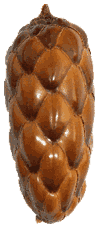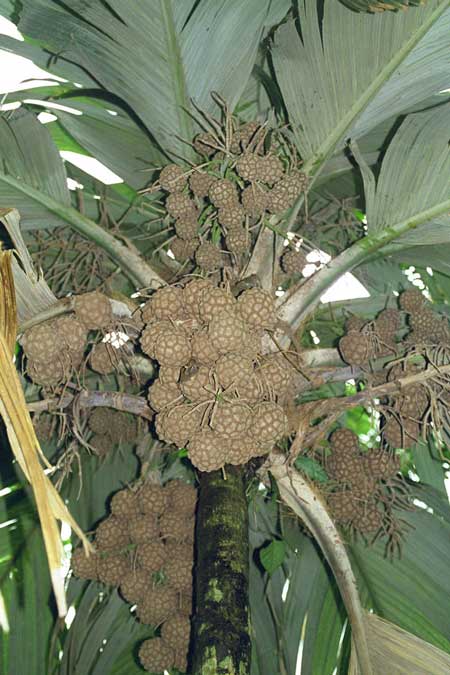 |
Palm |
 |
Palm |
There are no known wild populations; there are three documented anthropogenic sites in Vanuatu, Marquesas and Fiji Islands.
Pelagodoxa henryana belongs to the monotypic genus Pelagodoxa (Pelagodoxeae: Arecaceae). It is an unarmed, solitary palm to 11 m height. The stem is up to 15 cm diam, and the leaf scars are closely spaced. The leaves are large, undivided, pinnately ribbed with a bifid apex, and may extend to 3 m long and to about 1 m wide. The upper surface is green and glabrous, and the lower surface has a distinctive silvery glaucous bloom. The petiole is stout and short, to about 22 cm long. The leaf bases are densely tomentose, do not form a crownshaft but have a loose entanglement of fine fibres along the lower margins. It is monoecious, and the inflorescences are interfoliar, not extending beyond the leaves and paniculately branched. The fruit is globose, with a corky warty epicarp that is tan colored at maturity. Three size cohorts occur that differ mostly in proportion (the two smaller ones ripen with a pulpy, orange, fragrant mesocarp, the largest ripens to a tan fibrous mesocarp): 2.0 cm diam. (Vanuatu); 5.5 to 6.0 cm diam. (Fiji); 10 to 15 cm diam. (Marquesas).
Pelagodoxa henryana is found in cultivation or anthropogenic habitats with a peculiar distribution pattern attributed to human dispersal. The fruits have poor dispersal by floatation in water. Populations have been documented from the Marquesas Islands and Melanesian Islands of the Southwest Pacific, including San Cristobal and Mikiri Harbour, in the Solomon Islands. The type species, P. henryana was found in Nuku Hiva, Marquesas Islands. The smallest fruited Pelagodoxa was vouchered in 1983 and observed and documented in Vanua Lava, Vanuatu, with reports of an inland population on at least one island. Pelagodoxa henryana has naturalized in many of these regions. It is also found in cultivation throughout many private and public botanical gardens. Seeds of the Marquesas and Fiji source palms have been documented to produce viable seed. The anthropogenic sites may suggest a food source or famine food, as the fruit endosperm is edible.
 |
| A mature plant of Pelagodoxa henryana showing the curiously warty fruits. (Photo by M. H. Chapin) |
Pelagodoxa henryana is already extinct in the wild. Being monotypic, Pelagodoxa represents a significantly greater loss of biodiversity than a genus with numerous species. The Southwest Pacific islands have been identified as having the highest proportions of the most highly threatened palms in the world. Although P. henryana has been observed reproducing in the wild, the small number of individuals that are known do not represent a healthy, viable population structure. The known populations are subject to habitat destruction, and in cultivation the palm seedlings are highly susceptible to fungal attacks and disease. While seed banking protocols have recently been applied to palms, the large seed size does not make this palm a good candidate for seed storage.
Pelagodoxa henryana has attracted a great deal of interest historically and currently resulting in research, ex situ collections, and private collections. Documented ex situ collections of the Fiji and Marquesan source palms are managed within botanical gardens internationally.
Recommended management strategies include: protection of habitat areas in the Marquesas and Vanuatu populations; invasive species management and long-rang monitoring; establish new wild populations; establish effective genetically diverse ex situ populations; collaborate to accomplish conservation biology research; adhere to invasive weed, pest management, and quarantine procedures; conduct molecular studies that include all known individuals and populations in the Marquesas, Fiji and Vanuatu. Repatriation (out-planting) from cultivated sources should be considered.
Melany H. Chapin, Ph.D., Bishop Museum Research Associate, Hawaii, USA.
John L. Dowe, Ph.D., Australian Centre for Tropical Freshwater Research, James Cook University, Townsville, Qld 4811 Australia.
Beccari, O. & Pichi-Sermolli, R.E.G. 1955.
Subfamiliae Arecoidearum Gerontogeae tribuum et generum conspectus.
Webbia 11: 1–187.
Bois, D. 1917.
Pelagodoxa henryana Beccari. Palmier nouveau des Iles Marquises.
Revue Horticole 89: 302–304.
Bois, D. 1919.
Sur le Pelagodoxa henryana.
Bulletin de la société botanique de France 66: 12–13.
Bois, D. 1924.
Le Pelagodoxa henryana Beccari, nouveau palmier de serre chaude.
Revue Horticole, 2nd series, 19: 139–140.
Brown, F.B.H. 1931.
Palmae. In: BROWN, F.B.H., Flora of southeastern Polynesia 1. Monocotyledons.
Bernice P. Bishop Museum Bulletin 84: 117–128.
Burret, M. 1928.
Eine neue Art der Palmengattung Pelagodoxa Becc. aus der Südsee.
Notizblatt des Botanischen Gartens und Museums zu Berlin-Dahlem 93: 286–288.
Chapin, M.H., F.B. Essig & J.-C. Pintaud. 2001.
The morphology and histology of the fruits of Pelagodoxa (Arecaceae): taxonomic and biogeographical implications.
Systematic Botany 26: 779–785.
Chapin, M.H. & J.L. Dowe. 2005.
Pelagodoxa henryana — fruit variations and human dispersal agents.
Palms & Cycads: Palm & Cycad Societies of Australia (PACSOA) 88: 14–19.
Corner, E.J.H. 1969.
Pelagodoxa henryana Becc.
In: A preliminary analysis of the palm flora of the Solomon Islands. H. E. Moore (ed.).
Philosophical Transactions of the Royal Society of London, Series B 255: 589–593.
Dennis, G. & C. McQueen. 1989.
Palms of the Solomon Islands.
Palm and Cycad Societies of Australia. Queensland, Australia.
Dowe, J.L. (ed.) 1989.
Palms of the South-West Pacific.
Palm and Cycad Societies of Australia. Queensland, Australia.
Dowe, J.L. & P. Cabalion. 1996.
A taxonomic account of Arecaceae in Vanuatu, with descriptions of three new species.
Australian Systematic Botany 9: 1-60.
Dowe, J.L. & M.H. Chapin. 2006.
Beccari’s “grande nouveauté”: the discovery, taxonomic history and typification of Pelagodoxa henryana.
PALMS 50: 185–192.
Essig, F.B., T.J. Manka & L. Bussard 1999.
A systematic histological study of palm fruits. III. Subtribe Iguanurinae (Arecaceae).
Brittonia 51: 307-325.
Gillett, G.W. 1971.
Pelagodoxa in the Marquesas Islands.
Principes 15: 45-48.
Hallé, F. 1978.
Arbres et for Lts des Iles Marquises.
Cahiers du Pacifique 21. Pp. 315-357.
Henry, [M].C. 1918.
Les îles Marquises — flore et cultures.
Bulletin de la société nationale d'acclimatation de France 10: 315–320.
Martelli, U. 1932.
Pelagodoxa henryana Becc., palma della Isole Marquesas.
Nuovo Giornale Botanico Italiano, n.s. 39: 243–250.
Moore, H.E. Jr. 1957.
Pelagodoxa henryana.
Principes 1: 173–175.
Moore, H.E. Jr. 1979.
Order Arecales. Arecaceae.
In: Smith, A.C. (ed.), Flora vitiensis nova. A new flora of Fiji (Spermatophytes only). Vol. 1., pp. 392–438.
Pacific Tropical Botanical Garden, Lawai, Hawaii.
Phillips, R.H. 1996.
Pelagodoxa henryana in Fiji.
Principes 40: 148–151.
Stauffer, F.W., W.J. Baker, J. Dransfield & P.K. Endress. 2004.
Comparative floral structure and systematics of Pelagodoxa and Sommieria (Arecaceae).
Botanical Journal of the Linnean Society 146: 27–39.